RESTORING OUR HISTORIC AND TREASURED ORGAN

VOLUME 18 N 1
2023 THE MAGAZINE OF THE AMERICAN
SPRING
CATHEDRAL IN PARIS
The Magazine of The American Cathedral in Paris SPRING 2023 - VOLUME 18 N 1
Interim Dean and Rector
The Rev. Timothy Safford
Cathedral Canon
The Rev. Nathaniel Katz
Canon for Music
Zachary Ullery
Canon for Development
Jeb Seder Editor
Ellen Hampton
Senior Editor
Nancy Janin
Assistant Editor
Kelley Bass
Art Direction/Design
Anastasia Komnou
Please send comments to: The American Cathedral in Paris 23 Avenue George V 75008 Paris France
publications@americancathedral.org www.americancathedral.org
ISSN 2610-296X
PHOTO CREDITS:
Cover photo by Lauren Van Weyenburgh. Organ campaign photos by Kate French; organ colloquium photos by Rhoderic Bannatyne. Stacey Jones and Brett Spencer wedding photo by Sophie Béraud. Pope Francis at the December 2022 meeting by Iris Teplitzky.
Looking forward from a multicultural path
Je vous remercie, it’s been a privilege
Quand je suis arrivé à Paris à Pâques 2022, je ne parlais pas un mot de français.
While I have traveled the globe extensively, I have never lived for an extended period outside the U.S. I have a new appreciation for how exhausting it can be to navigate daily life without knowing what’s being said, getting lost in different norms and customs. While I am only a temporary ex-pat, I came to appreciate that the American Cathedral is not just a place to fill our spiritual selves but an oasis of familiarity for our American lives.
Maintenant, je peux bien lire le français, et je peux même écrire un peu de français, mais quand vous me parlez français, je suis perdu!
Still, the American Cathedral is evolving into a bilingual, multicultural community, reflecting the profound demographic changes in the United States. French is frequently spoken here by Americans, even with each other! I performed a marriage service that used four languages, all
spoken by the extended families of the Parisian couple. By and large, the Sunday worshipping community is the most diverse ethnically and racially I have ever served. That’s been a privilege.
Je retourne au Massachusetts cet été, et je n’ai pas pu prêcher un seul sermon en français ! Quel dommage!

Well, maybe not. But I’ve made good progress with my elementary French. I can haggle at the market, and shopkeepers no longer start speaking English at first sight (before I even speak!). I can give directions in French to the lost visitor (relying on pointing and hand waving).
The beauty of the faith we share is that it needs few words in any language to communicate its deepest truths. We embrace. We serve. We kneel. We give. We listen. We sing. We hope. We praise. We wonder. We wait. We repent, which means we take the risk of stopping, turning, and going in a new direction. We hope and we love unceasingly and with abandon.
3 LETTER FROM THE INTERIM DEAN
I have seen this every day at the American Cathedral during my time as Interim Dean. You welcome the stranger. You reach toward the stars. You trust in God’s forgiveness, abundantly.
Now, it’s time for all of us to let go. It’s time to stop playing “tug-o-war” with the past. Its tether pulls us backward, but by letting go, we fall into the future that God has prepared. When we build our relationship with God on what has already happened, we might feel disappointment. The journey of faith is to trust that God engages us from what will happen in the “what has yet to come.”
Getting closer to naming a new dean
Since mid-June 2022, the nine-member Discernment Team has been hard at work to choose the person God is calling to be the next dean of the American Cathedral in Paris. The beginning weeks were devoted to getting to know one another and understanding the job at hand. We adopted norms to guide our work together and studied volumes of documentation on search processes provided by the Convocation Transition Officer Linda Grenz. We appointed a chaplain, corresponding secretaries, technical supports, and liaisons with the Vestry, the Communications Committee and other bodies in order to be well organized when our work began in earnest.
In September we received reports from the Visioning Committee and the Vestry outlining needs and desires expressed by the parish and its leaders. After careful study and discussion through October and November, we condensed this material into a list of seven weighted criteria against which to evaluate the applications for the position. By November 30, the closing date for applications, we had received 46 applications from a broad range of candidates from across the United States and Canada. Each application included a letter of motivation, CV, the Office of Transitional Ministry form developed by the National Church and answers to
The future of the American Cathedral in Paris is safe and secure in the everlasting arms of God’s love and providence.
Je me souviendrai toujours de mon temps à la cathédrale américaine avec beaucoup d’affection. Grâce à vous, je suis un meilleur pasteur et j’espère un meilleur citoyen du monde. Je vous remercie vivement!
With gratitude,
Timothy Safford
11 standard questions. Each 12- to 15-page application was carefully studied by each member of the Discernment Team. Using the weighted criteria to guide our evaluations, by December 19 we had reached consensus on 18 applications we wished to study further. We listened to sermons, watched online services and searched the web, social media and other sources to learn as much as possible about these candidates. We met again on January 8 to further evaluate, and again by consensus, narrowed the pool to 10 candidates whom we wished to interview. A first round of interviews took place before February 5, at which time we met and agreed to conduct a second round of interviews with five candidates. Following reference checks, the Discernment Team hopes to make a presentation of finalists to the Vestry before mid-March. The Vestry will then take over the process and make the call to the next dean.
4
The Discernment Team: Sophie Belouet (convener), Mark Adams, Jacques Bossoney, Barbara Diggs, Jeanne Fellows, Audrey Jolivet-Habiby, Adrien LeSure, Andy Platt, and Mary Victor.
LETTER FROM THE INTERIM DEAN
by Blandine Marcé
The 20s/30s group: Finding one’s place in a diverse community
The 20s/30s group was my introduction to the American Cathedral in Paris. Like many of the group’s members, I was new to both the Episcopal Church and the Cathedral, arriving from another church whose standpoints didn’t match my views any longer.


begin with an ice-breaking question, often related to the time of the year, such as “What is your favorite Thanksgiving dish?” or “What do you want to let go of for the new year?”
Then we turn to the theme of the day, reading together an excerpt from a book or a Bible passage, which helps us unravel our thoughts. The first session I attended featured Accidental Saints by Nadia Bolz-Weber, a thought-provoking and witty book that led us to consider the challenge of praying for people who are difficult to love. Although seriously led, the discussions always take place with a spirit of compassion, allowing a space for vulnerability, sharing and support, which has made these sessions precious to me ever since.
Canon Nathaniel Katz steered me to the group, which he described as “a rapidly growing and enthusiastic group meeting twice a month, on the first Wednesday evening of each month for discussion here at the Cathedral, and for a social outing in Paris after church on a Sunday morning.” This is a pattern of meetings that the group – which counts a dozen members – continues to follow, albeit with some variations.
Our Wednesday discussions usually take place in the Fleetwood Room, a nice, cozy space with a beautiful fireplace, where we sit around a large table. The meetings
The social exchanges are important in creating bonds and welcoming new people to our community. Beautiful moments are shared while hiking in the woods, picnicking on the banks of the Seine, or celebrating the joy of Epiphany with a delicious galette. Sometimes the celebration focuses on important life moments: the baptism of a new member, a reception by the bishop into the Episcopal Church, or a goodbye party for those leaving Paris.
5
We support each other through these changes, and continue reaching out to new people.
AT THE 2022 MINISTRY FAIR, L-R: BLANDINE MARCÉ, VIVIANA GOBBATO, ORPHÉE GUIMENDEGO AND ADRIEN LESURE
For people in our age group, the nature of life is transient, as we move to new cities for studies, work or love. Between 2022 and 2023, the group lost some valued members whose visas for work or study ended. But we support each other through these changes, and continue reaching out to new people. As with many other groups, we welcomed newcomers at the Ministry Fair. To keep members up to date with our activities, we use a WhatsApp group and regularly send out a newsletter, along with publishing event announcements in the Cathedral’s bulletins.
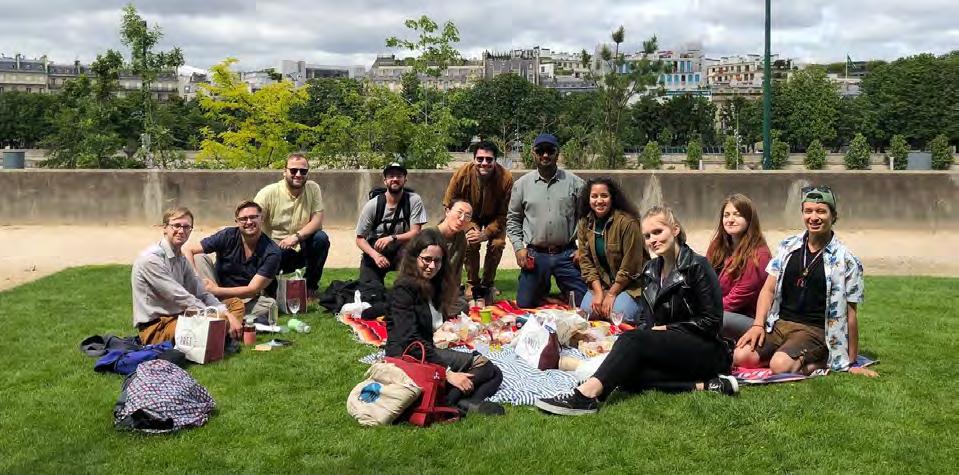
things, like washing and putting strawberries on a plate for the Pentecost celebrations, to a significant role in organizing the Posada festivities, preparing the lunch for the whole congregation and setting up a piñata.
Though the 20s/30s group has existed for many years at the Cathedral, it had a relaunch in February 2021 with new leadership and is striving to keep growing. It survived a pandemic, using Zoom calls to continue the sessions, sharing fellowship and time for prayer online. It survived people leaving the group for new horizons and navigated some disagreements inside the group itself.
But that is the beauty of our community, as the American Cathedral in Paris puts it so well: wherever you are in your spiritual journey, wherever you come from, you can come here, and ask for support, or simply share the joy with us. We don’t know what the future holds, but if we can continue to provide this safe space of discussion and these shared moments of community with people who need it, then we will have fulfilled our mission.
As a group and as individuals, the 20s/30s want to be involved in many projects. In January, members renewed their wish to volunteer to help homeless people or refugees, for example. This commitment is also toward the American Cathedral in Paris, as we see ourselves as an active part of the church, looking to build connections with other ministries and broader projects. This ranges from little
Blandine Marcé first came to the American Cathedral in Paris in 2021. Through her family history, she has strong ties to both French and American cultures. She works as a documentalist and volunteers as a writer and archivist.
PICNICKING ON THE BANKS OF THE SEINE
6
The
20s/30s group: Finding one’s place in a diverse community
“It brought to me a chance to appreciate that I wasn’t ‘alone’.”
ANTONIO MERINO
A 20S/30S MEMBER AND GROUP LEADER
by Craig R. Whitney
Organ restoration aims to enhance sound
Philipp Klais brings family expertise and inspired vision to the project
Philipp C.A. Klais, the head of a large family organ building company in Germany, has what he calls “a hope, a dream, a vision” to restore and revive to full brilliance and warmth a great musical treasure: the pipe organ originally installed in our American Cathedral in 1887 by the legendary French builder Aristide Cavaillé-Coll.
Klais’s great-grandfather, Johannes Klais, founded the firm in Bonn in 1882, and since then Klais Orgelbau GmbH & Co. has built hundreds of instruments all over the world. Philipp Klais’s ambition – to give the organ a voice that can move all in the pews and choirstalls to want to join in making a joyful noise – stems from a childhood memory. He worried as a young boy in church on Sunday that if he sang loudly enough for people sitting nearby to hear, they would wonder why he, the son, grandson and greatgrandson of organ builders, couldn’t sing better.
“I believe singing together is the strongest way we have of expressing the faith we hold in common,” he declared. Restoring the full tonal richness of the organ and
improving the acoustics of the Cathedral, he hopes, will inspire all who come to worship to sing out.

From the start more than a century ago, the organ could not be heard as distinctly and clearly as worshippers, or even Cavaillé-Coll himself, expected. He and his successors tried to remedy that by adding more pipes between 1887 and 1922. In 1993, more than a thousand pipes were added in a new antiphonal division in the rear gallery, but still problems remained.
Klais regards Cavaillé-Coll as “one of the most fantastic organ builders who ever existed on this earth.” And he feels strongly that to replace the original organ with a completely new one would be a terrible mistake. “It is such a treasure,” he observed. Cavaillé-Coll did not approach the American Cathedral project in the same way he did in building the great organs of Notre-Dame, Saint-Sulpice, and Sainte Clotilde in Paris. “It was designed in the French tradition, but in a way that respected the unique Anglo-American choral tradition.”
7
In that same multicultural spirit, Klais believes that success in restoring it requires respect for the French tradition as well: “We felt we needed a partner who knows the cultural context extremely well and in whom we had trust and confidence.”
His partners are from a Belgian company that collaborated with Klais in Germany before going out of business in 2020 after 50 years. One of the sons of its founder, Dominique Thomas, now voices and repairs organs with a firm in his own name in Belgium, and his brother Samuel, who set up Thomas Instruments in Luxembourg with some of their former company’s workers, will make the team Klais leads a multicultural one.

The Klais workshop in Bonn ceased operations during World War II, but like most parts of the city it was not severely damaged in the conflict. A few years after the division of Germany by the victors into occupation zones, Bonn became the capital of West Germany – the Federal Republic of Germany – in 1949, until reunification of the country in 1990 restored Berlin as the federal capital.
During that time Bonn, Beethoven’s birthplace, grew from a pleasant provincial university town on the Rhine a few miles south of Cologne, into a sophisticated cosmopolitan city. Growing up there, Philipp Klais, born in 1967, became familiar with many of its international residents and their ways, including Americans, and learned to speak English fluently.
Klais Orgelbau is on the Kölnstrasse, a main street leading to Cologne. The workshop looks from the outside more like a block-long, two-and-a-half story, brick-faced school than a factory. Philipp succeeded his father, Hans Gerd Klais, as director of the firm in 1995, after literally growing up in the workshop complex, part of which has been the Klais family home for generations. He has worked in the foundry, where tin and other metals are poured and shaped into pipes that can be anywhere from inches to 32 feet long; the carpentry shop where wooden ones of oak, beech, and pine are crafted, and the cabinets that support the pipes and house the mechanisms for playing them are built, with the handsome organ cases that frame them and focus their sound for listeners.
Philipp and his wife, Elisabeth, raised two sons and two daughters in the family apartment in the workshop. They are all doing well pursuing other lines of work than organbuilding, but his older daughter still lives there with her husband. Her father considers the 65 skilled artisans who work with him as practically family members as well. “We think of ourselves of course as artists,” Philipp says on the company’s German-English website (www.klais.de), “but calling us craftsmen or craftswomen is also no insult.”
Klais Orgelbau has installed hundreds of instruments all over the world, including the United States, Canada, Russia, China, Australia, Japan, and even the Philippines. Philipp recalled a project there in 1975 to restore an early 19th-century organ from the village of Las Piñas with a thousand pipes, all made of bamboo stalks. A personal note: as a naval officer at the time stationed in Vietnam and briefly in Subic Bay in the Philippines, and as an organist, I played that one in 1969. Later, as a New York Times correspondent in Germany, I went to the workshop in Bonn to interview Philipp’s father about the restoration project. The organ had been air-freighted in crates to Bonn and Philipp, a boy at the time, remembers how the workshop had to be heated to 86 degrees Fahrenheit, with 90 percent humidity, to prevent damage to the bamboo. After the work was done and the instrument was taken in
8
THE ORGAN TEAM (L-R): DOMINIQUE THOMAS, PHILIPP KLAIS, ANDREW DEWAR, HUGO PILLEVESSE, SAMUEL THOMAS
Organ restoration aims to enhance sound
crates to Frankfurt Airport to fly home to the Philippines, the flight was delayed, and the Frankfurt Zoo offered to let the crated pipes wait in the airport’s tropically heated quarantine spaces for animals.
That proved unnecessary, but maintaining a stable environment is critical to keeping an organ in good condition – whether its pipes are made of bamboo, wood or tin. Half a century later, Philipp Klais hopes the energy problems that have arisen from the war in Ukraine will not leave the Cathedral too cold in winter for the work of tuning and revoicing pipes once the project begins.
stopknobs, as well as most of the pipes of the Grand Orgue and the Pédale. In the chamber above will remain many of the pipes of the Récit division whose sound is uniquely Cavaillé-Coll. Also enclosed behind movable shutters for crescendo and diminuendo, they will have more room to breathe than they have now and will be heard more clearly. So from the powerful Bombarde, Trompette, Clairon stops to its Diapason, Hautbois, and comforting Viole de Gambe and Voix Céleste registers, that essential part of the organ can speak and be heard as the great builder intended. The brilliant French Horn, Tuba, and Philomela stops of the Solo division will also be free to speak out – as Philipp puts it, “not shouting at you,” but singing and embracing listeners with warm, rich sound.
“We don’t want to do a complete reorganization of the instrument,” he said. “We intend to respect Cavaillé-Coll’s work in a way that we hope will last a century or longer.”
Together, the Klais and Thomas firms could have as many as 25 workers at a time in the Cathedral for the heaviest tasks, but most of the time fewer would be needed. The first big job will be in the back of the nave, where the plan is to remove the thousand pipes installed 30 years ago in the rear gallery, letting light shine in from the stained glass window. New pipes in bright, clearly voiced ranks would then be mounted into two handsome organ cases facing each other overhead between the pillars just after the entrance on either side of the aisle. There they can sing out with the congregation and reinforce the pipes up front or alternate with them in organ solos or concerts.
In front, on either side of the chancel, would be two majestic organ cases housing many of the pipes that over the years had been squeezed into the narrow chamber above the St. Paul-the-Traveler chapel. On the left side as seen from the pews would be the Positif, the section that accompanies the choir, with pipes enclosed behind movable shutters the organist controls with a foot pedal to increase or lower volume.
Into the case on the right side would be installed the console with the organ keyboards, pedalboards and all the
The acoustical limitations of the Cathedral’s structure, the short reverberation time that has had a dampening effect on organ and choral music-making from the beginning, will be offset by the installation of a digitally assisted system called Carmen that can increase reverberation in the sanctuary during music and singing. Reverberation is then instantly adjustable to lower levels so speakers (and sermons!) will not be befuddled or muddled by echoing.
Doing the work in stages over the next few years does not mean, Philipp promises, that worshippers will be without music when it’s going on. Most of the time, work on voicing, tuning, and cabinet work would be done not on all the pipes at once but by sections.
Philipp Klais’s work is, to him, a calling to shape instruments that reflect the culture and the history of the places where they stand, and to reach the hearts of the people who hear them. For the American Cathedral, this is his hope, and his heartfelt commitment.
Craig R. Whitney worked more than 40 years around the world for The New York Times, including as Bureau Chief in Paris from 1995-2000, when he served on the Vestry of the Cathedral and often played the organ. Among his books is All The Stops (Public Affairs, 2003), a tale about American organists and organ builders. He retired in 2009 and lives in Brooklyn.
9
“We intend to respect Cavaillé-Coll’s work in a way that we hope will last a century or longer.”
PHILIPP KLAIS ORGAN BUILDER
by Nancy Janin
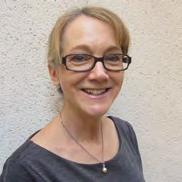
Make a Joyful Noise campaign reaches for €5 million
The Cathedral nave erupted in joyful noise indeed on Sunday, February 12, when the official kick off of the organ restoration campaign began with the announcement that €3.8 million had already been raised toward the €5 million challenge goal. Cathedral Treasurer Edward Bates, co-chair of the “quiet phase” of the campaign, thanked the 108 people who have already pledged.
Some commitments were made before the project was fully defined in order to finance technical studies and to raise awareness of the organ and its needs; to honor Dean Lucinda Laird upon her retirement; and in memory of parishioner Mike Seeley. In the last few months those pledges were supplemented by dozens more that came through the efforts of 18 trained volunteer solicitors who contacted Cathedral supporters individually all over the world. Edward Bates announced that every solicitor and member of the vestry and clergy had also already made their pledge.
As part of the presentation, campaign co-chair Thomas Girty spoke of the place of music at the Cathedral: “We are a community that rejoices in our music and the way it resonates and reaches so many here in Paris and, now thanks to our livestreaming, many around the world.” Cochair Jennifer Gosmand explained the plan for restoring the organ: “Under the guidance of Zach Ullery and Andy Dewar, we have designed a rebuild concept that will be technically, musically, architecturally and historically appropriate for our space.”
A video of organ builder Philipp Klais followed, including a virtual visit of his organ workshop in Bonn, Germany. The campaign’s “general phase” co-chairs, Elizabeth Procuronoff and Seth Hinkley, outlined the other projects included in the campaign – converting the nave lighting to a programmable LED system, installing an acoustic system to better support congregational singing and other activities, and increasing the Cathedral endowment to ensure that funds will be available for the music program
10
and maintenance of the organ. They encouraged parishioners to sign up to attend one of the many gatherings that will be held over the coming months, where they can learn more about all the projects. The campaign goal is 100% participation to meet the €5 million financial challenge goal.
Bishop Mark Edington closed the presentation with a rousing call to join those who have pledged. “Just you wait to hear what you are going to hear when this is done!” he said, reminding the congregation that fearless investment in our future inspires those observing from within our convocation but also those looking in from the outside, who often have no or even a negative idea of what churches are all about.
After the closing prayer, the congregation moved to the back of the nave to enjoy lunch together, to celebrate the wonderful thing that we are doing together and to contemplate the moment when our nave will ring out even more loudly and clearly with Joyful Noise.
Note: The 20-minute presentation can be seen on the Cathedral’s Facebook or YouTube channel, easily accessible on the Cathedral website. Look for the February 12 service – the presentation begins at 1h29m30 of the service. https://www.youtube.com/ watch?v=lXaZC5spEuI&t=5366s


Nancy Janin is co-chair of the “quiet phase” of the capital campaign, senior editor of Trinité, treasurer of the American Cathedral in Paris Foundation and member of the Board of Foreign Parishes.

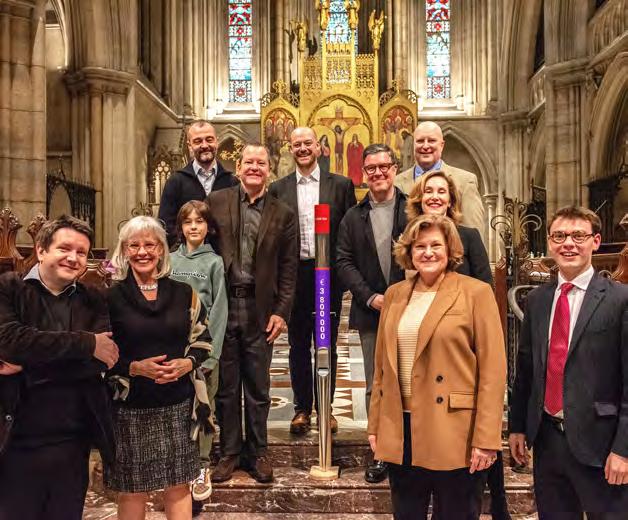
11
ABOVE, THE CAPITAL CAMPAIGN TEAM, ALL SMILES! BOTTOM LEFT, CATHEDRAL TREASURER EDWARD BATES AND HIS SON THÉODORE PULL THE BIG REVEAL BOTTOM RIGHT, BISHOP MARK EDINGTON URGES PARTICIPATION
Pledge
to the Capital Campaign. Scan here, or go to: amcathparis.com/capitalcampaign Donations may be made in dollars or euros.
“A manifestation of beauty”: our historic organ
Let’s just say the “Organ Colloquium: What’s Under the Hood?” was a blast. To explain how an organ functions, organist Andrew Dewar called up volunteers from the audience and handed them a piece of metal pipe, varying from the size of a drinking straw to that of a small rocket. When each person blew into it, a note sounded. Andy organized the line in the order of an ascending scale, and musical director Zach Ullery directed the volunteers in a tooting intro to Joy to the World.
The organ was built in 1886-87 by Aristide CavailléColl, the master designer and constructor of 500 organs, including those in the Cathedral of Notre Dame, the Basilicas of Saint-Denis and Sacre-Coeur, and the churches of Saint-Sulpice and Sainte-Trinité. His genius in inventing new means for sound opened up symphonic possibilities, and composers and musicians have lauded his work ever since (see Trinité, Fall 2022, for more on Cavaillé-Coll).
But time wears on pipes, bellows, windchests and pneumatics, and the organ is in dire need of restoration. Frédéric Blanc, organist at Notre-Dame d’Auteuil (also a Cavaillé-Coll) and member of the Paris City Commission for organs, said that the last work done on the cathedral’s organ in 1993 addressed many of the problems identified at the time, but after almost 30 years of joyful expression the time for revision is now. Problems of placement and lack of sound egress, noted since the time of the organ’s installation, will finally be rectified, and the instrument Frédéric described as “a manifestation of beauty” will sing out for generations to come.
Organized by the Capital Campaign committee, the January 10th forum was a prequel to the fundraising drive. Commentary on the history and significance of the cathedral’s 136-year-old organ was offered by five organ experts, interspersed with a bagpipe number and the cathedral choir singing George Dyson’s “Star Wars” Magnificat. (Zach was only half-joking about the title, it was indeed intergalactic.)

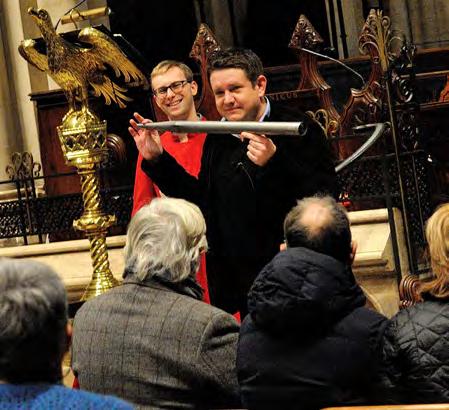
Details of the proposed work, summarized at the forum, are presented in detail in the article in these pages. It would be carried out by Philipp Klais of Orgelbau Klais of Bonn, Germany, and Dominique Thomas of Thomas Instruments of Stavelot, Belgium, both of whom attended the colloquium. Carolyn Shuster Fournier also gave a brief biography of Cavaillé-Coll, and Johann Vexo, organist at the cathedral of Nancy and at Notre-Dame of Paris, explained the differences in organ use in French Catholic services.
– Ellen Hampton
12
PARISHIONERS HAVE A BLAST
ORGANIST ANDREW DEWAR EXPLAINS WHEN A PIPE IS A PIPE
Postwar romance – and a change of army rules – brought a surge in WWII weddings

 by Ellen Hampton
by Ellen Hampton
13
U.S. NATIONAL ARCHIVES PHOTO
Postwar romance – and a change of army rules – brought a surge in WWII weddings
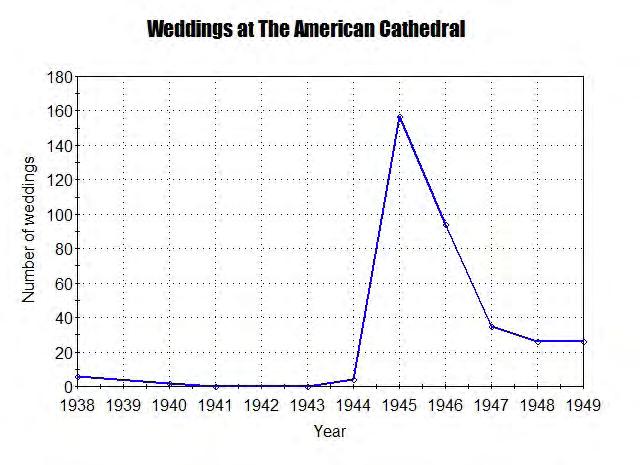
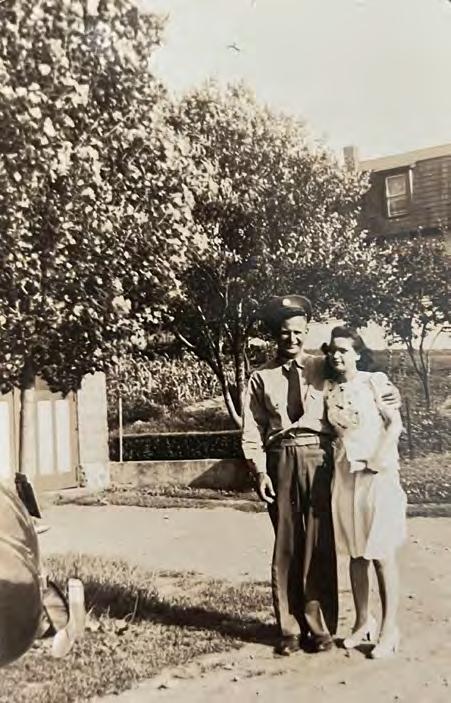
After the end of the darkest of wars, the City of Light seemed to have rekindled its talent for romance in a twinkling, sending a record-breaking rush of couples to the altar at the American Cathedral. From a handful of weddings per year in the late 1930s, to none during the Occupation, the Cathedral heard the wedding vows of more than 150 couples in 1945.
It should come as no surprise that most of them were American military personnel. In the Paris area, from September 1944 to July 1945, 50,000 U.S. troops were busy rebuilding roads, bridges and airfields, setting up supply lines and maintaining Signal Corps communications. Among them were some 8,000 members of the Women’s Army Corps, and several thousand women also working in Paris for the American Red Cross.
Love was definitely in the air, but there was another reason for the sudden marriage madness: effective June 9, 1945, the U.S. Army rescinded its rule that couples on active duty who married would be posted far apart or one of them sent home. Army authorities had learned that, because of the rule, couples had been living together without benefit of marriage, while commanders turned a blind eye to relationships in their ranks. It was a scandal waiting to happen. With the end of hostilities in May 1945, Army officials saw the wisdom of a tactical retreat.1
Members of three families who have returned to visit the Cathedral in recent years to commemorate family weddings during the postwar period agreed to share their stories with Trinité.
Horvath-Hosfeld
Sgt. Louis Horvath and Lt. Alberta (Bert) Hosfeld felt that five years was long enough to wait. They had met in their hometown of Bethlehem, PA, in 1939, and both had enlisted in the U.S. Army, Louis in an engineering battalion and Bert in the Nurse Corps. Both were stationed in England in spring 1944, and both crossed to France, Louis in June, just after D-Day, and Bert in October. Bert spent the next six months in Cherbourg at the 280th Field Hospital, while Louis fought his way across eastern France toward the deadly Battle of the Bulge in January 1945.
Their daughter, Deborah Jones, said in a telephone interview from her home in Indiana that her father used to tell her and her sister war stories when they were small.
Study
Army Corps in the European Theater of Operations, 1945, https://usacac.army.mil/sites/default/files/documents/carl/eto/eto-011-1.pdf, p. 57.
14
1.
of the Women’s
LOUIS HORVATH & ALBERTA HOSFELD – JULY 20, 1941
“We were fascinated by them,” she said. “He would get out the map and show us where he’d gone for reconnaissance and all. We thought it was utterly the coolest thing in the world.”
At one point Bert was told that Louis had been killed, his entire unit wiped out. She checked all the Red Cross casualty lists, breathing again only when his name wasn’t on them. With peace declared in May 1945, they met up in Paris, and on June 27, 1945, Louis and Bert exchanged vows before an Army chaplain at the altar of the American Cathedral. Afterwards, they held a civil ceremony at the mayor’s office of the 9th arrondissement of Paris. The Stars and Stripes newspaper had fun with the fact that they paid for the civil ceremony with some cash, a Hershey bar and a pack of Lucky Strike cigarettes.

Deborah said she once asked her mother how she had held on, knowing the danger her father was facing. “She said, it was a leap of faith. We all prayed a lot.”
After the war they returned to Bethlehem, and then moved to Princeton, IN, where Louis ran the Boys Clubs and served as American Legion and VFW post commander; Bert continued a part-time nursing career. Neither of them ever got back to Paris, despite always hoping to do so. Louis died in 1981 and Bert followed in 2005. But they had started a family tradition, and when their granddaughter, Stacey Jones, and her fiancé, Brett Spencer, wanted to get married, they came to Paris. On December 16, 2022, Stacey and Brett stood where her grandparents had exchanged their vows just over 77 years ago.
“Being in that space where my grandparents were also married so many years ago, and knowing all of the waiting and worry and sleepless nights they each endured hoping to get to see one another again – thinking about that, and about the joy they must certainly have felt once they were finally able to marry, filled me with a hopefulness that I just haven’t known in my life,” Stacey wrote in an email. “It was overwhelming in the best way.”
Of the 157 weddings at the American Cathedral in June 1945, Louis and Bert counted among 90 couples who were active-duty military or American Red Cross personnel. (In this era, only male-female weddings were permitted.) The numbers dropped slowly: in 1946 there were 94 weddings, in 1947, 35; in 1948 and 1949, 26 (see graph).
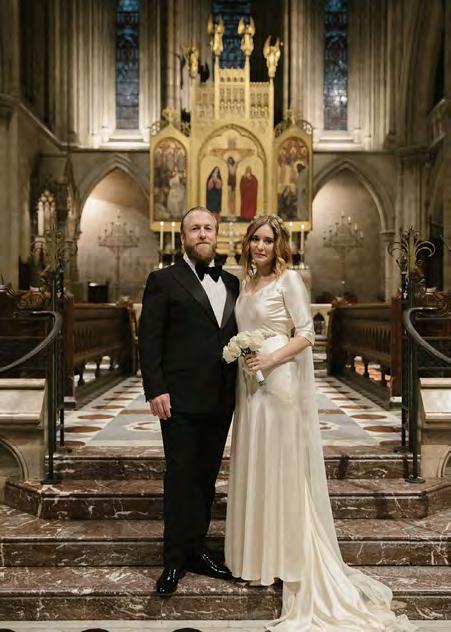
Potter-Wiler
“It was so exotic then, to say ‘We were married in Paris,’” said Benjamin Wagner, grandson of another military couple who married at the Cathedral. Carroll Potter and Zelda Wiler were both in the U.S. Army’s Signal Corps, Carroll maintaining equipment and Zelda decoding messages. Zelda, at 4-foot-11, was judged too small for the Women’s Army Corps in her home state of Illinois, but the Pentagon snapped her up after seeing her test scores.
During the war, Carroll had been posted mostly to Italy, and Zelda had been in London until September 1944, when the intelligence corps moved into the Hotel George V. Six weeks after they met in Paris, they decided to get married. They had a civil ceremony at the mayor’s office of
15
LOUIS HORVATH IN UNIFORM
BRETT SPENCER AND STACEY JONES MARRY AT THE CATHEDRAL TOO
Postwar romance – and a change of army rules – brought a surge in WWII weddings
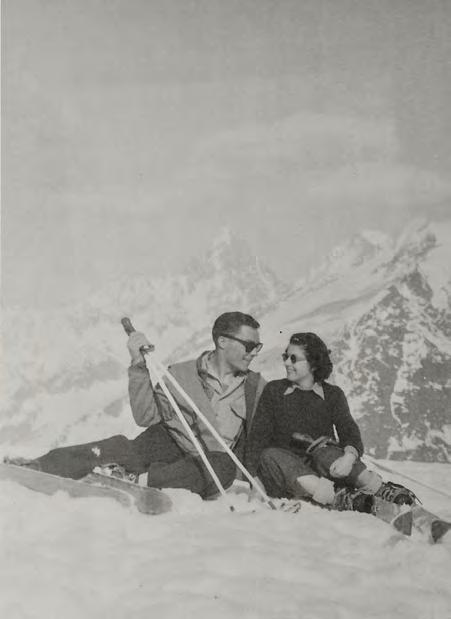

the 8th arrondissement on March 22, 1946, and exchanged vows at the Cathedral the following day.

“It was truly a love story,” said their daughter, Nancy Potter-Johnson. Nancy, along with her son Benjamin and her sister, Barbara Simons, visited the Cathedral in September 2021 to see for themselves the iconic place where the family had begun. Carroll and Zelda had five children between 1947 and 1961; Nancy is the oldest and lives in
Arizona. They had heard about the war and their parents’ time in France their whole lives, she said. Show-and-tell in school, for them, nearly always meant bringing French francs and army souvenirs their parents had kept.
After the war, both Carroll and Zelda were stationed in Brussels for about a year, and then returned to Carroll’s home state of Nebraska. They started a freezer-locker business and worked together for the rest of their lives. Zelda died in 1994 and Carroll passed, at the age of 87, in 2010.
In 1945, 55 marriages (about a third of the total) at the Cathedral were between U.S. military men and French women, with another 52 American-French weddings the following year. What became of the French women who followed the handsome GI in uniform back home? That is the subject of Hilary Kaiser’s book, French War Brides: Mademoiselle and the American Soldier. She interviewed 25 French war brides, of an estimated total of 6,000, and found that about half of them stayed with the marriage, and half did not.
16
CARROLL POTTER AND ZELDA WILER MARRIED IN MARCH 1946
ON THEIR HONEYMOON AT CHAMONIX
DAUGHTERS NANCY POTTER-WAGNER AND BARBARA SIMONS AND GRANDSON BENJAMIN WAGNER VISIT THE CATHEDRAL
“Quite a few of the marriages turned out well, but many of the women had been young and ‘starry-eyed’ right after the war and had married hastily,” Kaiser wrote in the introduction. “Consequently, they hardly knew their husbands when they arrived in America. Incompatibility, lack of communication due to language differences, and cultural and socioeconomic issues often resulted.”2
The Women’s Army Corps reported that across the European theater, only eight of 323 marriages in the first seven months of 1945 were with men of other nationalities. After the Army policy was changed, the number of WAC weddings increased four-fold, reflecting the trend in Paris. Most were with other American soldiers: going through a war together seemed to be a solid preparation for lifelong partnership.

Duncan-Beighley
Iley Duncan and Esther Beighley didn’t wait for the rule change, which, in fact, had been announced the month before. They stood at the altar of the American Cathedral on June 1, 1945, with Iley newly promoted to sergeant by his commanding officer so as not to be out-ranked by his WAC-sergeant wife. Iley was the CO’s driver, and while Esther had started out in the military police, she was then doing administrative work for the Women’s Army Corps.
After the war they settled in Iley’s hometown of Phoenix, AZ, and he began a career with Reynolds Metal Company. They had three children and lived on a small cattle ranch. Iley did not want to leave his livestock, but in her later years Esther traveled the world, including a return to Paris. Iley died in 1997 and Esther in 2016; they are buried at the veterans’ National Memorial Cemetery in Phoenix.
The Duncan family has continued the tradition. In 2006, their son Dennis and his wife Carol came to the American Cathedral to renew their wedding vows, and in October 2022 granddaughter Dina and her husband Luke Schlosser did the same.

“The church means a great deal to our entire family, and we hope to keep our special and unique tradition alive for generations to come!” Luke wrote in an email. “What a beautiful and meaningful place.”
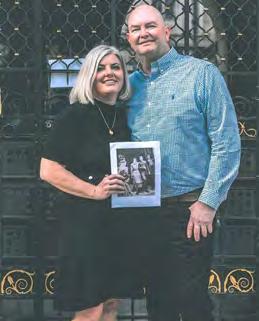
17
2. Hilary Kaiser, French War Brides. Mademoiselle and the American Soldier, New York: Paris Writer’s Press, 2017, p. xxix.
Ellen Hampton, a historian and author, is editor of Trinité magazine. She has been a member of the American Cathedral for 30 years, and also serves on the Archives committee.
ESTHER BEIGHLEY AND ILEY DUNCAN AT THEIR JUNE 1945 WEDDING
DINA AND LUKE SCHLOSSER RENEW THEIR VOWS, 2022
CAROL AND DENNIS DUNCAN RENEW THEIR VOWS, 2006
by The Rt. Rev. Mark Edington
Episcopal, American, Anglican: the strands and stresses of identity
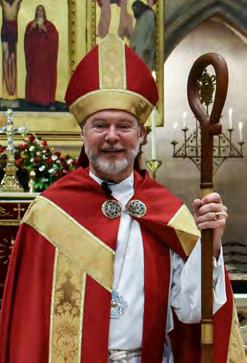
This turns out to be a year of anniversaries in the Convocation. As I write, we are feverishly preparing for the centenary of the Cathedral’s consecration as the Episcopal cathedral for Europe; Presiding Bishop Michael Curry will be visiting us for a revival and a liturgy of thanksgiving and celebration. Earlier this year, on January 25th, Saint Paul’s Within the Walls of Rome commemorated the 150th anniversary of the laying of its cornerstone with a festive service of Evensong, attended by a constellation of guests from the ecumenical community that makes Rome its center. And later this year, on June 11th, Emmanuel Church in Geneva will celebrate the 150th anniversary of its founding by a community of Americans living there.
The fact of these milestones being clustered in a single year invites reflection on just why it was these churches were founded—and what bearing, if any, that history has upon our future. It is hard to deny that the communities that founded these parishes did so with no small amount of confidence in a newly ascendant United States. They saw a deep connection between the way in which religious tolerance and the principle of non-establishment had been part of the foundational principles of the American republic, and the growing influence of the United States. Consider these words of The Reverend Robert Jenkins Nevin, the rector of Saint Paul’s, Rome, on the day that cornerstone was laid:
“We are building now, not in any spirit of petty triumph over a fallen order of things, nor of any wanton aggression upon, or loud-mouthed controversy with, any form of Christian faith; but we are building first to meet the absolute religious
needs of our own people, and to set forth worthily the reasonable worship that is dear to us at home, and not less that rightful liberty of conscience which is the first and most sacred of human rights, and without which no government, however wisely framed, can ever hope to stand.”
Nevin—and the generation of those who founded these churches of ours—deeply believed those words. They genuinely felt they were offering back to Europe an idea for how the relationship between civil authority and religious belief should be constructed. They saw it as an essential and distinctive characteristic of the American experiment—and they were not ashamed to be known as American.
For much of our respective histories, we have generally been known by our neighbors, wherever we are, as “the American church.” There are still stamps in the prayer books of Saint James’s, Florence that read “Saint James American Church.” The Convocation itself was formerly— but in living memory—“The Convocation of American Churches in Europe.” And that is by no means an accident; back in the United States, in the same historical moment that our churches here were being planted, the Episcopal Church began to think and speak of itself in terms of what one scholar of our history, Bishop Ian Douglas, has described as “the national church ideal.” In a nation with fissiparous denominational identities, the Episcopal Church sought to claim for itself the high ground of being a church of the nation, able to accommodate both the Protestant traditions that had first come from Europe and the Roman Catholic commitments of those who, in the late
18
nineteenth century, were America’s newest immigrants. That is why a building customarily called Washington “National” Cathedral occupies a vantage point looking down upon America’s national capital.
This has inevitably been a source of confusion, if not contention, as we have sought to hear and respond to God’s call in mission over the generations. That statement itself is perhaps contentious: it claims that we are here to be a church, a gathering of faithful Christians seeking and following Jesus Christ, and not an American culture club at prayer. A consequence of that claim has been the shedding of “American” from the public identities of all of the Convocation’s congregations, with the exception of the Cathedral. But there is another, deeper challenge here—the relationship between “American” and “Episcopal.” An inheritance of the founding narratives of many (but not all) of our congregations is the idea—the mistaken idea—that one is somehow subsumed in the other. Today, with more and more of our members coming from a formation in faith outside the Episcopal tradition (or any tradition), that can be a stumbling block as we take responsibility for forming a new generation in what it means to be an Episcopalian, and what the Episcopal Church is. As soon as we encounter things we find confusing or disagreeable about it, the tendency can become to simply dismiss those as “American”—as though that was a fundamental flaw.

It is certainly true that the Episcopal Church is the distinctively American expression of the Anglican tradition. It is not true, however, that the Episcopal Church is, or can be dismissed as, an “American” church; it is a church present in eighteen nations, of which the Convocation encompasses seven. Yet the forces at work in the founding of the United States, and especially the vigilance with which America’s framers sought to limit the concentration of power, left clear traces on the distinctive shape of the Episcopal Church—especially in the way our polity works.

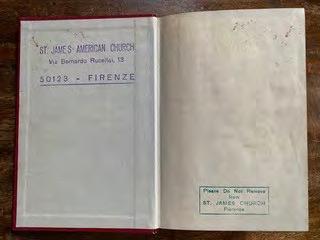
In our version of Anglicanism, the authority of bishops is circumscribed; the people have a much larger voice in the governance of parish and polity; and the sensus fidelium is discerned with the involvement of a far broader spectrum of the faithful. That is why this church moved to ordain women in 1976; that is why this church elects its bishops, and elected the first woman to the episcopate in the Anglican communion (who, as it turns out, is the same bishop who ordained me to the priesthood). That is why this church elected the first man who would not deny he was gay to the episcopate in 2003; and that is why this church stands for the full extension of all ministries of the church, and all sacraments offered by the church, to all people. Not because it is an American church; but because it is an Episcopal Church.
Within this moment of recalling our founding stories is a call to discern the difference between what is essential to our identity as a church in Europe, and what are the gifts that brought us here but do not shape our onward journey. What does it mean hold onto our identity as the Episcopal Church in Europe, appreciating but not beholden to our founding story? How can we both learn and hand on to a rising generation just what it means to be the “Episcopal branch of the Jesus Movement”—a phrase we will surely hear from the Presiding Bishop? Are we so sure we know what this distinctive tradition, this expression of the Anglican idea, is? There is no corner of the Episcopal Church where that conversation is more significant, or more fruitful of creativity and innovation, than the Convocation. In this season of celebrating anniversaries, I give thanks for the new challenges to which we are now called—and for the tools our ancestors equipped us with for responding to them in faith and joy.
See you in church,
19
LETTER FROM THE BISHOP
NEW BOOKS
Books by parishioners

Bastille Day, the fifth novel by our Canon Theologian Dr. Greg Garrett, will be published April 4 by Raven Books, an imprint of Paraclete Press. The book follows an American journalist in Paris as he falls in love, covers the Bastille Day terror attack in Nice, and is forced back into crippling memories of his years covering the war in Iraq. The American Cathedral is a primary setting for the novel, and a fictional Dean, Canon Pastor, and vestry members serve as major characters. Greg’s first novel, Free Bird, was named to the coveted Publishers Weekly First Fiction List; his most recent, The Prodigal, was published by an imprint of HarperCollins and translated into German, Dutch, Spanish, and Portuguese editions. In sum, he is the author of almost 30 books, many of them at least partially written during his time at the Cathedral. Greg’s next nonfiction book, The Gospel according to James Baldwin, will be published in the fall by Orbis Books.

Doctors at War: the Clandestine Battle against the Nazi Occupation of France, by Ellen Hampton, was released by Louisiana State University Press in March. Her second history of the World War II period, it outlines the government persecution of Jewish doctors, the organization of medical resistance groups in the Paris area, the ingenuity of doctors operating in forest guerrilla camps, and the
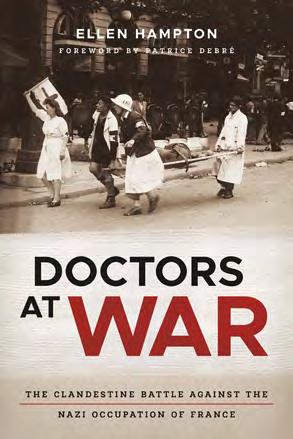
courage of those who were arrested and deported to concentration camps. The role of The American Hospital of Paris, and its American chief medical officer, Dr. Sumner Jackson, is documented.
Anne Marie Reijnen and Chad Dilley meet Pope Francis
Parishioner Anne Marie Reijnen and her husband, Chad Dilley, met Pope Francis in a private audience in December as part of the Amitié JudéoChrétienne de France group. Anne Marie, a Protestant pastor, professor of theology, and vice president of the group, offers a look at its history:
In 1943, the wife and daughter of the illustrious Jewish French historian Jules Isaac were arrested by the Gestapo as they were traveling together. Laure and Juliette were deported to Auschwitz and murdered. In 1947, Jules Isaac (1877-1963) dedicated his major book, Jesus et Israël, to both of them, killed “because they were called Isaac.” Isaac was the main force behind the birth of the Amitié JudéoChrétienne de France (AJCF) and a principal organizer

20
Community News
of the groundbreaking 1947 conference in Seelisberg, Switzerland, where Christian participants from 12 nations signed the “Ten Points of Seelisberg,” a sort of charter for Christian preaching, teaching and liturgy regarding the Jewish faith.
Jules Isaac was extremely keen to impress on the Catholic Church the need for revising its tradition of antiJudaism. He traveled to Rome first in 1949, and then far more successfully in 1960, when Pope John XXIII was transformed by the meeting with him. Isaac asked: How can the deeply ingrained “teaching of contempt” change into a “teaching of esteem”? The question was placed on the agenda of the Second Vatican Council in 1965 (Nostra Aetate).

More recently, in 2008, the umbrella organization International Council for Christians and Jews promulgated the “Points of Berlin,” avowing that it was “time for recommitment” – a text that demands to be taken to heart. In that direction, the Amitié Judéo-Chrétienne de France will dedicate its work in 2023 to honoring the legacy of Jules Isaac.

Spring
A refresher pause for Canon Zachary Ullery
After nearly 15 years of directing the Cathedral’s music program, Canon for Music Zachary Ullery will take a hiatus for the spring and summer to refresh his ministry, study choral conducting, and even improve his French. He plans to travel to four countries and spend several weeks at a silent retreat in Gethsemane, Kentucky, his home state. With the organ restoration project moving forward in high gear, and a new dean due in the fall, Zach will return September 1, committed to opening a new chapter of his ministry at the Cathedral.
Interim Dean Timothy Safford is seeking donations to the Dean’s Discretionary Fund to help Zach sustain the sabbatical, from direct funding to unused airline frequent flier miles. Please don’t hesitate to contact Zach directly at music@americancathedral.org.
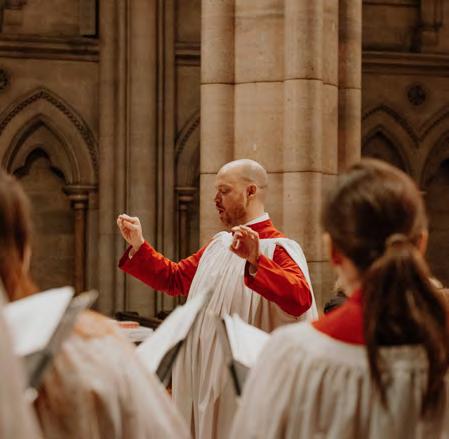
21
II AT MEETING DECEMBER 2022
2023 POPE FRANCIS
Community News
Mary Adair Brown Johnson
November 10, 1930-April 20, 2022
Mary Adair and her husband Don retired to Paris in 1996 after having lived here (and in Strasbourg and Brazil) during Don’s professional career. Both were very active volunteers in the Parisian expat community, both inside and outside the Cathedral. Mary Adair was perhaps best known for her years of dedication to Les Arts George V, the Cathedral’s musical outreach association. With Don as president and Mary Adair as vice president, they tirelessly worked to bring music and cultural events to the Cathedral, supporting young artists and generating funds to support the Cathedral music program. Their focus on music seems appropriate since Mary Adair met Don at church choir practice in Shreveport, Louisiana. Mary Adair moved to Bowie, Maryland, shortly after Don died in 2015, to be closer to family. She is survived by two sons, Kurt Adair Johnson Sr. and Guy Lewis Johnson, and a daughter, Eve Johnson Wilson; four grandchildren, and seven greatgrandchildren.
Edward Dey
November 11, 1937-November 2, 2022
Edward met his future wife Odile, one of a family of 16 (!) children from Normandy, when he was assigned to Paris with the Foreign Service. They moved around a good bit, giving birth to their only daughter, Alix, in Chicago. They settled in Paris for good in 1983, at which time Edward changed his career to banking. The Dey family joined the Cathedral with Edward soon becoming a staunch member of the vestry, serving often on the investment and finance committees. Edward did parishioners a great service in establishing the Cathedral as a 1901 Association in the late 1980s, thereby giving individuals tax deductions for their fulfilled pledges and donations. Ed was always ready to help others in their efforts. Jennifer Gosmand offered the following tribute:
“Ed Dey was a forthright, elegant man and longtime dedicated parishioner with a gentle sense of humor, a Princetonian to the core. I had the pleasure of serving with him on the Vestry and was grateful to him for sharing his financial expertise in setting up the Trinity Society, of which he was one of the founding members, in 2007.” Ed is survived by his wife Odile, daughter Alix Tabusse and two grandchildren.
Gail Jertson Worth
October 5, 1936-November 19, 2022
Former Junior Warden, vestry member, and head of the Altar and Junior Guilds, Gail graduated from St. Lawrence University in 1958. Just out of college, Gail had a career as an actor and dancer in musicals and later joined IBM as a systems engineer, where she met her husband Douglas C. Worth. She left paid work to accompany Doug and their two children as his career took them to Paris, Lisbon, and New York, and back to Paris when Doug had a posting with the OECD. In both of her stays in Paris Gail was devoted to the Cathedral, and continued her participation and generosity through the Friends of the American Cathedral in Paris. Throughout her life Gail enjoyed tennis, golf, cooking, and choral singing. A service was held in December at Christ Church in Ponte Vedra Beach, Florida, where she and Doug had retired. She is survived by her husband, a daughter, Leila Tiffany Worth, a son, John Stephen Hartmann Worth, and two grandchildren.
Boynton Mott Rawlings
December 6, 1935-December 20, 2022
Graduating from Princeton University in the class of 1958 – in the same class with longtime friend Edward Dey (see above) – and with a degree from Stanford Law School and a post-graduate degree from the University of Strasbourg, Boynton came to Paris to practice law in 1967 and set up his own law office in the early 1970s. A practicing lawyer for five decades, he had a rich and rewarding career in international corporate law. A lifelong lover of music, Boynton was a member of the Princeton Tigertones and a founder of the Paris Choral Society, which has been practicing and performing at the American Cathedral for almost 30 years. Wit, humor, intellect and joie de vivre were his in abundance and are the attributes for which he will be remembered by his family and numerous friends from all walks of life. Boynton is survived by his wife, Kathy Strickland Rawlings, his daughter, Laura Rawlings, his sons James Rawlings and William Rawlings, two stepdaughters, and five grandchildren.
– Nancy Janin and Kate Thweatt

22
In memoriam
John Singer Sargent and Holy Trinity parishioners
Their profile is one of a well-todo but unremarkable family. New York-born Mary Elizabeth Tomes married Swiss silk merchant and amateur artist Edward Burckhardt, and from 1870 they lived in Paris with their two daughters, Valerie and Louise, and a small dog named Pointy. Destiny brought them to the limelight when they met a budding young artist named John Singer Sargent. He drew or painted portraits of all of them – even the dog.
First was a pencil drawing of Valerie Burckhardt in 1878, then, as a wedding present to her, he painted a portrait of her father in 1880. Then it seems that Mrs. Burckhardt attempted to set up Sargent with Louise, her younger daughter, whom he painted in 1882 in his largest portrait yet (Lady with a Rose), which hangs today at the Metropolitan Museum of Art in New York City. Romance did not bloom, however, and in 1885 (to make amends?) Sargent painted Mrs. Edward Burckhardt and her daughter Louise, as well as a small portrait of Pointy, dedicated “to my friend Louise.”

Louise Burckhardt had been confirmed at Holy Trinity in 1879 and married Englishman Roger Ackerley there in 1889. Valerie moved to New York with her husband, Harold Farquhar Hadden, a wealthy silk importer. After Holy Trinity inaugurated memorial pews in 1923, Valerie dedicated Pew 96 to her mother.
How many other Holy Trinity parishioners were captured by the extraordinary brush of John Singer Sargent? Stay tuned.
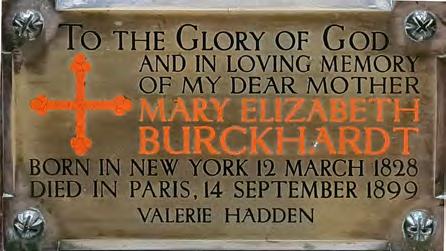
From the Archives
23
Make a Joyful Noise!
The American Cathedral in Paris is graced by the work of artistic genius Aristide Cavaillé-Coll, the great 19th century French organ builder.
The organ is the heartbeat of the Cathedral’s liturgy and musical outreach program, but it is in dire need of restoration to allow it to fulfill its potential as a significant cultural landmark in Paris through the next century. In addition, acoustical and lighting improvements are necessary elements of presenting services and cultural events in the Nave, and in order to protect our investment, an expansion of the endowment is called for.
This project is a call to action to the Cathedral congregation, our Friends, and music lovers around the world to make a bold commitment of vision, faith, and action through participation in the Cathedral’s Capital Campaign.
Subscribe to the campaign’s weekly e-letter, Point d’Orgue, for the latest updates on the campaign and the work it funds.
For more information, please contact the Campaign committee at organ@americancathedral.org

















 by Ellen Hampton
by Ellen Hampton
























